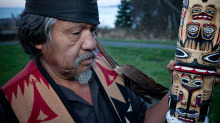The Lethal Illusion Called 'Authority'by William Norman GriggMay. 06, 2011 |
Popular 
Report: Hamas Says Witkoff Promised to Lift Gaza Blockade in Exchange for Edan Alexander

Ben Shapiro, Mark Levin and Laura Loomer Warn of Foreign Influence... From Qatar

Eloy Adrian Camarillo, 17, Arrested in Shooting Death of Infowars Reporter Jamie White

NYT: Trump Ended War With Houthis After They Shot Down U.S. Drones, Nearly Hit Fighter Jets

Trump Advisor to Washington Post: 'In MAGA, We Are Not Bibi Fans'
  "Why did you shoot that man? He didn't do anything!" "Why did you shoot that man? He didn't do anything!"The question was wrenched from a woman who had watched in horror as Police Officer Ian Birk pumped four shots into the body of John T. Williams on a Seattle street corner last August 30. Birk claimed that he had been "threatened" by Williams, a 50-year-old alcoholic woodcarver who was carrying two closed knives at the time of the incident. The autopsy, however, documented that Williams wasn't facing Birk when he was shot: The officer approached him from behind and to the right, and Williams was shot in the right side of his body from an estimated distance of about ten feet. A fifth shot that missed the target was never accounted for. No reasonable person would have considered Williams a threat to Birk; in fact, since the victim was partially deaf, it's likely he never clearly heard Birk's demand that he drop his carving knife, and died before understanding what was going on. The entire lethal encounter lasted less than eight seconds. There were several eyewitnesses to the homicide. None of them saw Williams display threatening behavior of any kind. Then again, none of them was a member of the State's punitive caste, which means that they hadn't been indoctrinated to perceive even a momentary lack of cooperation by a Mundane as a "pre-attack indicator." During the January inquest into the shooting, Birk explained that he gunned down John T. Williams on a Seattle street corner because he didn't like the way the 50-year-old chronic alcoholic looked at him. While prowling Seattle’s streets last August 30, Birk saw Williams in a crosswalk carrying a knife and a block of wood. Birk reported that he was going to perform a "shake" – an informal contact with a potentially suspicious person. He exited his police cruiser and, with his firearm in the "Sul" position, commanded Williams to drop his knife. No more than four seconds passed between Birk’s demand and the first of five gunshots fired by the officer. The entire encounter lasted roughly seven seconds. Significantly, in the immediate aftermath of the incident, Birk specified that he had killed Williams for refusing to drop the knife, not because of threatening behavior of any kind. He also told another police officer that Williams "was carving up that board" – which, if true, meant that Birk had seen the knife used as a tool, rather than a weapon. In the dashcam video, Williams appears to be a small, middle-aged man with a shambling, tentative stride. While crossing the street the artisan does appear to be working with the wood in some fashion. Birk can be seen exiting the car and speaking casually into his portable radio before bellowing "Hey! Hey! Hey! Drop the knife!" Nothing in Birk's posture or tone of voice suggests that he was confronting a potential assailant, or in fear for his life. Perhaps the most important fact, given Birk's claim that he was "threatened" by the confused, partially deaf woodcarver, is the fact that the officer was the one who was closing the distance in the seconds leading up to the shooting. Williams had a troubled past characterized by alcoholism and occasional fits of improper public behavior. He was well known to the police as a "chronic inebriate." In a video recording of an earlier encounter one officer is heard telling another that "I write him a ticket every time I can."  In the days just prior to the August 30 shooting, Williams was stopped by police on several occasions. In one confrontation, Williams – who at the time was so deep into his cups that he could barely stand upright – can be heard making what was described as a "threat" to kill "all you police force." This "threat" wasn’t taken seriously by the officers, who simply shrugged their shoulders and let Williams shuffle away. The Seattle police were familiar with Williams, his alcohol abuse, and the occasionally unsavory public behavior that resulted from it. Officers had also seen him carrying a carving knife and a block of wood on previous occasions. While he wasn’t always pleasant to be around, Williams wasn’t known to be disposed toward violence, and in any case wasn’t physically capable of any. At the time Birk killed him, Williams was carrying two knives, both of which were legal under Seattle municipal ordinances (their blades were under 3.5 inches in length) and were closed when photographed by crime scene investigators.  Officer William Collins, who arrived in response to Birk’s "shots fired" report, told him, seconds after the killing, that he had done a "good job." All that Williams knew at the time was that a fellow member of his coercive brotherhood had just killed a Mundane – and that's all he needed to know. During the January shooting inquest, Seattle police brutality lawyer Tim Ford asked Williams if a closed knife constitutes a threat to "officer safety." A closed knife is "a major threat," Williams maintained, "just as big as an open knife.... It's extremely dangerous, and you have to treat the person with utmost caution.... [I]f you don't drop it, you may be shot" – even if it is closed at the time. After all, Williams insisted – regurgitating a familiar self-pitying police cliche – "We don't get paid enough to be hurt." (Actually, Seattle Police – like their brethren in blue elsewhere – are paid extravagantly to perform a job not particularly fraught with peril: The starting salary for SPD officers is more than $64,000 a year.) Detective Jeff Mudd, who also testified at the inquest, also asserted that Birk's decision was appropriate: "We're trained to shoot people who pose a threat to us." In what sense was this puzzled, decrepit old alcoholic, "armed" with a small, closed knife, a "threat" to the young, vigorous, highly trained paladin of public order who confronted him with a drawn gun? The answer offered by Birk was that he was justified in shooting Williams because the woodcarver had given him a dirty look. "He had a very stern, very serious, very confrontational look on his face," Birk testified during the inquest. "He was still holding the knife up in front of himself ... in a confrontational posture." Birk's use of the word "still" means that Williams's "posture" hadn't changed from the time the officer supposedly saw him "carving up that board" – which may have been unwise, but couldn't be construed as "confrontational." A detailed account of the inquest published by The Stranger points out: "No witnesses reported seeing Williams act aggressively toward Birk or anyone else. No witnesses reported seeing a knife in Williams' hand." Birk mentioned that he and other police are taught the "21-foot rule," which dictates that a knife-wielding subject should be considered a lethal threat within the prescribed distance. But it should be remembered that it was Birk who insisted on closing the distance. Birk also testified that "I motioned for him to come over and talk to me. He walked away." If Birk, pursuant to the "21 foot rule," considered Williams to be a "threat," why did the officer instruct the woodcarver to come closer? When asked to elucidate that point, Birk stated that "if he would've complied with that command, it would've been a sign that he was compliant with what was going on." Of course, if Williams had "complied" with that demand, it's entirely possible that he would have been gunned down anyway – and that Birk would have claimed that the victim had "threatened him" by closing the distance between them. In any case, since Birk had already drawn his firearm, the "21 foot rule" didn’t apply. Birk's testimony, which was clearly scripted for him, is a splendid example of what police call "creative writing" – or what more honest people call perjury. He claimed that somehow, during the course of their very brief encounter, he saw Williams become "increasingly aggressive.... His brow was furrowed, eyes were fixed in a thousand-yard stare. His jaw was set." Somehow, in a matter of nano-seconds, the forlorn and inoffensive American Indian woodcarver had – at least in Birk's eyes – assumed the fearsome demeanor of the ancient Irish warrior Cuchulain, whose "eyes were dark, his expression sullen." In a fascinating piece of performance art, Birk recreated for the courtroom the sullen expression and "attack stance" that caused the valiant defender of the public weal to soil his skivvies. The officer supposedly recognized and acted on these "pre-attack indicators" within the space of about four seconds. The situation "escalated more quickly than I had predicted," Birk insisted on the witness stand. So this was a "split-second decision," correct? Well – perhaps for the police officer, but not for the victim, who according to Birk had all the time in the world to comply. "Mr. Williams had ample opportunity to do a number of things preventing this situation from becoming what it ultimately became," Birk declared on the stand. Birk's lavishly detailed description of Williams' threatening behavior is difficult to reconcile with his own behavior in the immediate aftermath of the shooting. Nowhere in the video recording of the incident can Birk be heard telling other officers or onlookers that Williams had threatened him with a knife. In his on-scene interview with the above-mentioned Detective Mudd, Birk said nothing about "pre-attack indicators." In his testimony at the inquest – a pseudo-judicial procedure that is neither a criminal nor a civil trial – Birk recited his lines like a well-rehearsed soap opera actor, displaying the composure of a sociopath in assigning all of the blame to the victim. The jury at the inquest was not convinced that Birk had told the truth about the supposed threat posed by Williams. On February 15, Seattle PD's Firearms Review Board ruled that the fatal shooting was "unjustified," and recommended that "Officer Birk must remain stripped of all Seattle Police powers and authority, as he was on October 5th, 2010 when he surrendered his gun and badge." Birk had clearly committed an act of criminal homicide, and his only "punishment" was to be "stripped" of something nobody really possesses – the supposed power and authority to engage in discretionary killing. As we’ve seen on numerous occasions, contemporary law enforcement officers are on a war footing, which means that their default setting is "overkill." (Birk, like so many other police officers, is a military veteran, having served as a paralegal in the National Guard.) It likewise means that they are functionally immune from prosecution when they commit acts of criminal homicide. Shortly after the decision of the Firearms Review Board was made public, King County Prosecutor Dan Satterberg announced that although the murder of Williams was "troubling," no criminal charges would be filed against the murderer. This is because it Satterberg believes it would be impossible to demonstrate that the unjustified killing was the product of malice. "A jury would be compelled to find Officer Birk not guilty," Satterberg claimed. This should be taken as an oblique admission by Satterberg that he would have thrown the case if it had gone to trial. The state’s homicide statute recognizes that it is not necessary to demonstrate malice in cases where death results from criminal neglect. Furthermore, the relevant section Washington’s criminal code describes an offense called "homicide by abuse" in which one person, in "circumstances manifesting an extreme indifference to human life," causes the death of " a developmentally disabled person"; although this statute was written to apply to cases in which mentally handicapped or otherwise dependent people die from prolonged mistreatment, a properly motivated prosecutor could find a way to convince a jury that the statute should cover an incident in which a police officer summarily executes a deaf, mentally challenged woodcarver. As is generally the case when a member of the Krypteia slaughters a helot, the only ones punished are the local tax victims: The City of Seattle has announced a $1.5 million settlement with the victim’s family. Birk himself will probably join the ever-growing ranks of "Gypsy Cops" and turn up somewhere else swaddled in a government-provided costume and invested with the spurious authority to kill. Police authority" is a strange, mystical property that leaves a heavy residue of privilege even in those, like Ian Birk, from whom it is withdrawn. Consider what would happen if the situation had been reversed on that Seattle street corner last August 30: What if Birk had been ordered to divest himself of his weapon by a member of the productive class? What if Birk had been the one gunned down four seconds after that demand had been made by someone who later claimed that he felt "threatened" by Birk's facial expression? Were a sanctified personage in a police uniform to be killed in that fashion by a Mundane who displayed no malice, D.A. Satterberg would probably find the motivation, and summon the necessary creativity, to build a criminal case. In a recent case of that kind in Eugene, Oregon, a woman reportedly suffering from schizophrenia allegedly gunned down Officer Chris Kulcullin, who – his chosen profession aside – appears to have been a genuinely decent man, with a wife and two children. While the specifics of that horrible episode differ from the killing of John T. Williams, both of those incidents were random acts of unjustified lethal violence. Ian Birk faces no criminal charges. Cheryl Kidd, who allegedly murdered Kulcullin, has been charged with aggravated murder, and could face the death penalty. The only thing separating those two acts of criminal homicide is "authority" – that quantity, at once elusive and illusive, that supposedly elevates the State's hired enforcers above the hoi polloi, permitting them to inflict summary punishment on any Mundane who displays so much as a flicker of defiance. It is this ineffable gift that allows Ian Birk and his ilk to gun down, without serious consequence, any Mundane who dares give them a dirty look. __ William Norman Grigg [send him mail] publishes the Pro Libertate blog and hosts the Pro Libertate radio program. Copyright © 2011 William Norman Grigg |



